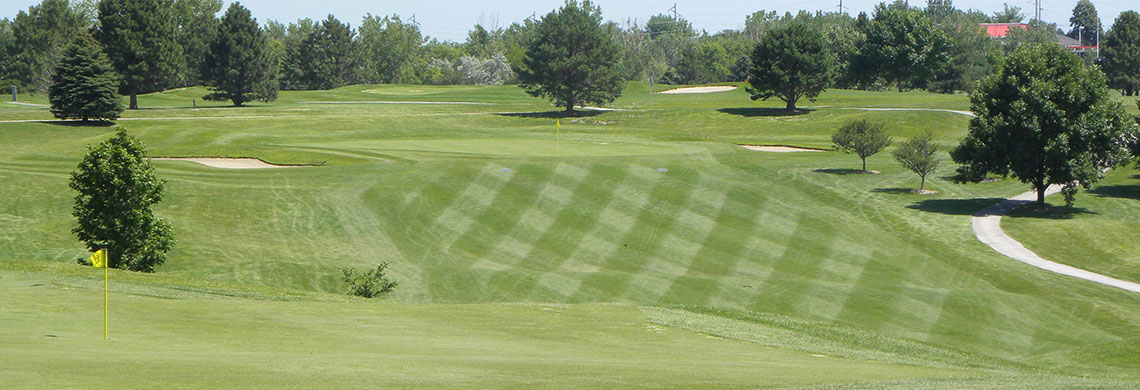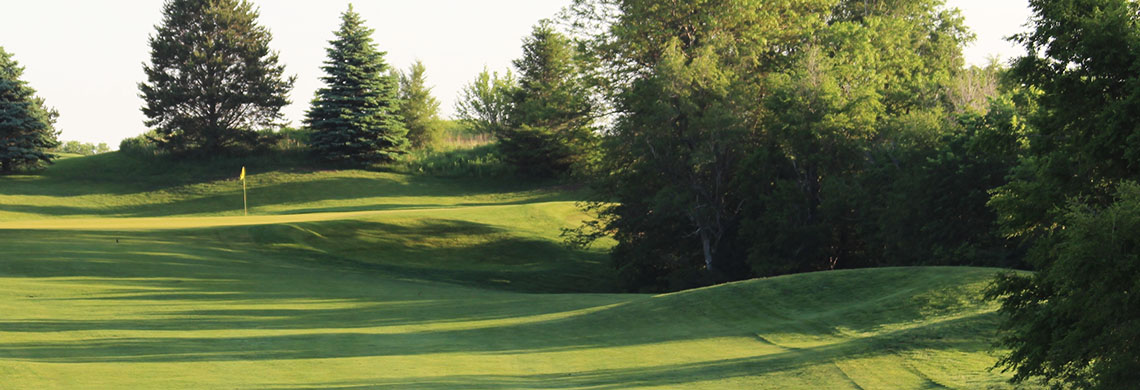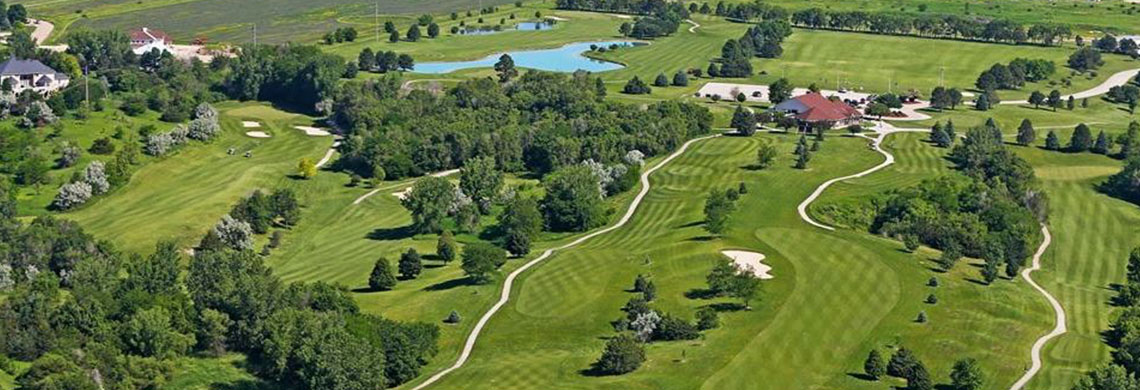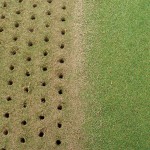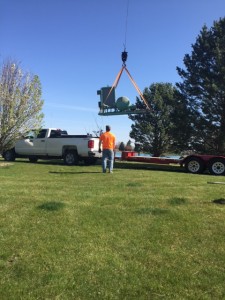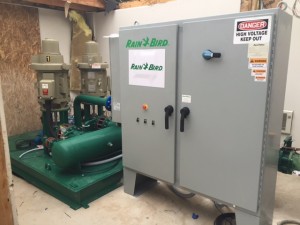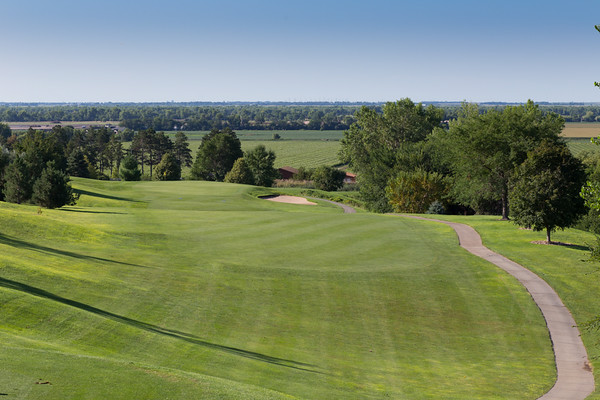Superintendents Blog 10.5.2022
As we all remember from last year, moisture is a big part of turf coming out of winter healthy. Currently we are in a drought, and have not had significant moisture in a while, and with the colder temperatures we have blown out our irrigation system. If it gets to the point where we need to turn the irrigation system on this winter we will, but we would need to have a few days where the temperatures are good for us, we do not want to have the irrigation heads freeze with water in them, and it takes us two days to blow out the irrigation system. We currently have 798 irrigation heads on the course, and if they freeze and break each head cost around $300. We will continue to haul water to greens when we need to water them throughout the winter. The goal is to keep the crown of the turf hydrated, and we can only hand water so much of the course with the irrigation system blown out. When the turf is dry in these cold temperatures it is very brittle and becomes extremely susceptible to damage from traffic. With our current conditions, I am recommending that we close the course to reduce as much stress on the course as possible, until we receive significant moisture or are able to keep the irrigation system on. I think that we all would rather have a course in the spring and the summer that is healthy and playable compared to what we had coming out of winter last year. Last year we started this drought and through the winter we had very mild conditions that allowed golf for the early part of winter. Most courses are taking a proactive approach this year, so to not have a repeat of conditions coming out of winter like last year. Like I said, we will turn on the irrigation system when we need to and can this winter, but with the cost of irrigation heads we are cautious, we want you to be able to play golf if conditions allow, if we get to that point this winter, we ask that you follow the rules with carts; staying away from greens and tees, following the ropes that we have on the course, or staying on cart paths. We all want to get out in the winter when we can, and we hope that we can provide a course for you to play, but mother nature will dictate when we are able to open.
 Robert Butler, GCSAA
Robert Butler, GCSAA
Meadowlark Hills Golf Course
Superintendent
Superintendents Blog 6.22.2021
#12 Hydraulic Leak
Hydrauli c leaks can happen with all types of golf course equipment, from greens mowers to power bunker rakes. As many of you have seen from playing the past week we had a substantial leak on 12 fairway. Hydraulic leaks happen, and you hope to see them before you do so much damage. This is not the fault of the guy mowing or the mechanic, sometimes these things just happen. With hydraulic fluid it is usually the heat that kills the turf right away and paired with the high temperatures that we have had you can really see the damage. With small leaks you can sometimes water it in and see less damage, but I did not want to spread it out and kill more turf. There are a few other factors that played into this particular leak. Most of the time you can see a hydraulic leak when you turn to make you next pass while mowing, but we were on our clean up pass around the fairway so he was mostly watching his outside reel as to not scalp the rough and did not see the leak on the inside. With most superintendents they say it is not a matter of if but when a hydraulic leak happens and you just hope to reduce the amount of damage.
c leaks can happen with all types of golf course equipment, from greens mowers to power bunker rakes. As many of you have seen from playing the past week we had a substantial leak on 12 fairway. Hydraulic leaks happen, and you hope to see them before you do so much damage. This is not the fault of the guy mowing or the mechanic, sometimes these things just happen. With hydraulic fluid it is usually the heat that kills the turf right away and paired with the high temperatures that we have had you can really see the damage. With small leaks you can sometimes water it in and see less damage, but I did not want to spread it out and kill more turf. There are a few other factors that played into this particular leak. Most of the time you can see a hydraulic leak when you turn to make you next pass while mowing, but we were on our clean up pass around the fairway so he was mostly watching his outside reel as to not scalp the rough and did not see the leak on the inside. With most superintendents they say it is not a matter of if but when a hydraulic leak happens and you just hope to reduce the amount of damage.
With that being said, we have a plan in place to establish turf in that area. With the high temperatures we are receiving and July still to come, sod would have been an option but would be tough to keep alive going into the summer months around here. We decided to aerify and topdress the area to pull out some of the dead and hydraulic fluid from the soil. All the cores from aerifyng were picked up and discarded, then we topdressed with sand and that was drug in to fill the holes and give a good base for seed to be planted. Next, we went out with the slit seeder and applied a mixture of bluegrass seed. We will be watering that area regularly for the next few weeks, so if you see irrigation heads on in that area don’t be alarmed we are just trying to keep the seed wet. With play we ask that you try to stay off of this area as much as possible and know that we are working on fixing this problem.
Robert Butler, G CSAA
CSAA
Meadowlark Hills Golf Course
Superintendent
Superintendents Blog 9.10.20
1. We aerate to improve, not annoy
Putting greens receive more traffic than any other playing surface. The aeration process helps relieve the compaction caused by all that traffic. It also helps create a firm,
smooth puttingsurface by controlling thatch and promoting healthy turf roots.
2. Scratch the thatch
Thatch is a layer of old plant material that accumulates at the soil surface. If thatch on putting greens is not diluted by aeration and topdressing, it will act like a sponge,
holding waternear the surface. Excessive thatch creates soft playing conditions, inconsistent green speeds and increases the risk of disease.
3. Timing is everything
Do you ever wonder why aeration is commonly performed when putting greens are playing their best? Aerating when grass is healthy and actively growing minimizes
damage and allows
for a quick return to optimal playing conditions. Aerating at other times may be more convenient for the golf schedule, but it lengthens recovery times, increases the
risk of an invasion of
weeds and could cause lasting damage.
It may seem like there are more holes than grass on the putting greens right after they’ve been aerated, but this is an illusion. Typically, aeration affects less than 10 p
ercent of a
putting surface.
5. Sand is part of the plan
A heavy application of topdressing following aeration may appear to make putting greens less playable. However, filling aeration holes with sand actually helps create
a smoother surface. Sand also creates channels for water and air movement, dilutes thatch and helps putting greens recover from aeration more quickly.
Rex Rodehorst
Golf Course Superintendent
Superintendent Blog 11.15.19
People often wonder what our staff of three full time maintenance employees do during the fall/winter when the course is closed. Well, we keep busy as we have 80 golf carts to
maintain, 5 greens mowers, 2 tee mowers, 2 fairway mowers, 2 rough mowers, 2 six-foot mowers for trimming, 2 sand pros, 3 workmen and 31 sets of reels to sharpen. With our new
grinder we are excited to use that to sharpen the reels!
We order chemicals and supplies for the upcoming year as well as maintain our weekly inventory of parts and supplies needed to maintain our fleet of equipment. We also attend
continuing education to keep abreast of the latest trends in golf course maintenance.
Planning for 2020 began on timelines and project spreadsheets back in August. Using this as a planning guide helps complete tasks!
Rex Rodehorst
Golf Course Superintendent
Superintendent Blog 9.30.19
The year of 2019 started out wet! A big snow melt occurred on March 12th which left the course flooded in areas and very wet elsewhere. Dan Knipping resigned as Golf Course Superintendent in March. Rex Rodehorst was hired as Superintendent and an assistant – Bob Butler was hired but did not begin his employment full time until mid-June. With one man down during the busy wet spring, delays occurred including our sprayer not working, which required repairs taking three weeks, and mowing began three weeks late due to excessive moisture.
Sand was removed from the greens on March 27th, and our team began mowing tees and fairways on April 1st. At this busy time of year, our team consisted of the superintendent, golf course mechanic and three part time seasonals to get the course open.
Record rainfall of 10” occurred in May. 4” of rain came during State Golf, reducing the tournament to one day, instead of two. Memorial Day weekend found another 3” of rain in the rain gauge, which had the course closed due to flooding on Sunday and Monday which is usually a very busy weekend at MHGC.
Three full time staff was busy in May pumping water off of Holes #2 and #4. The ground was already saturated from previous rains, and water had no where to go over the old landfill, which is under holes #2 and #4. We have four pumps that would pump for six hours. We would also rope off the fairways on #2 and #4 so carts were only on the cart paths.
Summer seasonal help started in May and we had 9.5 seasonals who worked a 30-40-hour week.
July was another wet month with 10” of rainfall. This led to more pumping of water, which takes manpower hours away from projects and regular duties. Our seasonal help was an exceptional hardworking crew from May to August and they kept the course maintained at the highest level.
In September, to help drain the low areas on #2 and #4, we solicited help from the Water Department. They brought out a boring machine and it bored a 4” drain pipe , four foot underground, 160’ long at the beginning of #2 fairway. Closer to the green on hole #2 we put in 300’ of drain pipe to take the water off the fairway.
On hole #4, we put 180’ of drain pipe near the middle of the fairway, four foot underground. Installing the drain pipe took three full days and three full time employees.
Once we completed the drainage system on #2 and #4, we had minimal rain in September and October, however it was nice to see the drains working. Our project for this winter will be hauling approximately 200 yards of dirt onto the #2 fairway, to fill in the holes and provide surface drainage.
Aerification of greens occurred in July and at the end of September we aerified and pulled cores out of the greens. We top dressed the greens with 25 yards of sand to fill in the holes. This is a four person job: one person operates the walk behind aerifer, second person picks up the cores that are left by the aerifer on the edge of the greens, third person operates the top-dresser which spreads sand onto the green, and the fourth person pulls a broom behind the workman which sweeps the sand into the holes. To aerify 18 holes takes four people 12-14 hours. We aerify later in the season so play is not disrupted.
Fall fertilization of rough, tees and fairways takes 240 bags of fertilizer and takes 1.5 people approximately three days. Pre-emergent is applied in the spring on the entire course and throughout the year we spray for different diseases.
Rex Rodehorst
Golf Course Superintendent
Superintendent Blog 6.18.19
Spring is finally here and we are happy to see everyone out playing. Update: The cart path around the #6 tee boxes is in progress with two of five phases complete. We are excited to finally get this project completed and I’m sure so are all of our patrons. We now have sand and seed bottle refills for your golf carts near the putting green for replacement when making the turn. Just a friendly reminder to always fill in your divots with the sand and seed on the carts.
Superintendent Blog 5.15.18
Spring is finally here and we are happy to see everyone out playing. Update: The cart path around the #6 tee boxes is in progress with two of five phases complete. We are excited to finally get this project completed and I’m sure so are all of our patrons. We now have sand and seed bottle refills for your golf carts near the putting green for replacement when making the turn. Just a friendly reminder to always fill in your divots with the sand and seed on the carts.
How about how the Course looks coming out of Winter? Our seasonal staff is on board now so that will help speed up projects.
Thanks for your understanding.
Dan Kinipping
Golf Course Superintendant
Superintendent Blog 3.1.17
It has been a good winter so far at Meadowlark Hills Golf Course. The moisture we received this fall and winter has been very good for the course, but we are going to need some form of precipitation soon. We filled the irrigation system and are checking heads for repairs. We apologies if a head turns on.
The maintenance crew completed servicing all of the maintenance equipment and golf carts. Our staff has taken advantage of the nice weather and has cleaned up the course from pruning tree limbs and picking up sticks that have fallen during the winter. Staff also completed repairs and poured the cart path on number 8 by the canal.
For those of you wondering why we haven’t mowed, it’s because mowing promotes growth and this could cause damage if we would get a cold spell. Which could happen between now and March! It also helps if we allow the soil temperature to reach 50 prior to mowing for the first time.
Our staff hopes you get out and enjoy the nice weather in February and we will be mowing as soon as we can!
Superintendent Blog 9.15.16
Well it is that time of year again when the greens are perfect and we need to punch hole in them….YES, Aerification time. On Monday, September 19, we will start with the aerification process. Dan Knipping, Golf Course Superintendent will explain the process and have some interesting, informative photos to post here and on our Facebook page.
Thanks, Dave James, PGA
Many people wonder why we aerify the greens. To tell you the truth I don’t like poking holes in the greens but it’s something we have to do. Aeration is the process by witch holes are put into the greens to allow for air to get into the soil beneath the surface of the green. It also breaks up compact areas, improves drainage, and promotes root development. Once we have poked the holes we put sand on the greens and the drag the sand around to fill the holes. Filling the holes with sand will help speed up the healing process. The sand also will help make the ball role a lot smoother. I’m sorry for the inconvenience but it’s something we have to do for the health of the greens and the greens should be rolling good again in no time.
Dan Knipping
Golf Course Superintendent
Superintendent Blog 4.15.16
We are excited to let everyone know that the new irrigation pump station is up and running. The whole installation process only took a few days and the installation was a success. Thanks for your understanding as the crew was working hard to complete the project without golf interruptions.
Superintendent Blog 2.16.16
Winterkill has been a significant problem the last two years at Meadowlark Hills Golf Course. This year staff was more pro-active in doing weather protecting on the course by adding more sand on the greens to protect the crown of the plants. This helps slow down moisture loss and to help protect against the cold winter wind. The four greens affected the worst by winter kill and wind were closed for the season. Snow fence was put up to collect snow and slow down the winter wind to help protect those areas. These were just a small part of an ongoing effort to keep winterkill at a minimum at Meadowlark Hills Golf Course.
Dan Knipping
Golf Course Superintendent
Superintendent Blog 9.19.15
We had yet another tough winter. The weather has been all over the place from wet to dry and cold to hot. We started the year with winter kill on our greens again making it challenging. The good news was the winter kill wasn’t as bad as last year and we didn’t loose any tees or fairways. Growing back the greens is a very slow process as the low temperatures need to above 52 degrees for bent grass to germinate. Sanding the greens helps as bent grass creeps into the sand areas. By the end of July the greens came back nicely with only a few bad spots on the edges.
Our new tee mowers and greens mowers have made a huge difference. They do a great job with cutting and are reliable which has saved time and money on breakdowns. We will be aerifying greens on September 22 & 23. We will not core but vent the greens by pushing the turf down instead of coring. This will allow for better playing conditions. Our plan is to aerify the rest of the course the following week.
Some fall projects you will be seeing are: Planting a few new trees, fertilizing everything, spraying herbicide (after the first frost), sodding bad areas around cart paths and working on some bad areas on hole #2 & #4. We also plan on starting a greens nursery north of our shop.
As far as winterizing the greens, we plan on putting down more sand on the greens and we may use a few temporary greens.
Dan Knipping
Golf Course Superintendent
Superintendent Blog 11.17.14
This year we started out with a huge challenge as we lost a lot of grass and the weather did not work in our favor for getting new seed to germinate as it should. I think every course in Nebraska suffered some grass loss and they also struggled with growing the bad areas back to normal. Thankfully the weather changed in June and everything finally started to heal up.
You probably noticed some work going on this summer and fall at our maintenance shop. Repairs were done on our 20 year old existing shop. This shop will now be used as equipment storage. A new shop has been constructed and will be largely utilized for mechanical repairs. The new shop includes a wash bay for mowers and carts, reel grinder room, staff offices, and tool storage. Golfers will be happy to hear that we also have public restrooms on the east side of the building that is accessible from the cart path going to hole #2 or #4. The new shop is scheduled to be complete in December.
We had a great fall (except we could have had a little more rain) for everything to finish recovering. The majority of the course recovered with very few thin areas remaining. We did the usual fertilizing and putting herbicide down. In order to help “blanket” the greens, we will be putting down a layer of sand. We replaced 22 trees in areas that trees had died and Dave wants to start adding a few more around the course. We will be working on the landscape around the clubhouse area as well as the around new shop later this winter. We also hope to start leveling a few tee boxes soon. Our staff worked really hard to complete these major tasks.
Thank you for the support through this difficult year and I pray for a wet winter.
Dan Knipping
Golf Course Superintendent
Superintendent Blog 8.13.14
I am writing this blog to inform everyone on what happened to the greens this year, how we repaired them and what we are currently doing to improve the shape of the greens
The problems we had this past winter were caused because of the warm, dry, windy conditions that took place. The wind caused most of the problems because the greens, tees and fairways that were sheltered by those North winds did not get as much damage.
Then we had a spring that would not warm up like usual. The soil temperature needs to be over 50 degrees for grass seed to germinate (bent grass likes even warmer conditions) and this did not happen until late April. Other experts I networked with agreed with me to wait until the soil reached 50 degrees to start over-seeding and that is why we waited so long to start seeding.
Our first attempt at over-seeding we verticut and used spike reels to make holes and then sanded. The second time we punched holes with the procore machine and sanded again and did the same thing a third time. We did this all two to three weeks apart so we could see how much seed germinated but we continued to hand poke holes every week in some of the real bad spots.
The results were slow and not real good. The weather was still not helping the cause because we needed heat and humidity and were getting none. Once we got that heat and humidity the seed finally started growing and the grass that made it started filling in. This is when we could finally start moving plugs and putting sand down heavier as well as utilizing temporary greens on holes two and fourteen.
With the new grass I was unable to use a growth regulator (which slows the vertical growth of the grass to help green speed) but the grass started to grow too fast and I finally started putting it on in late June. This is a tough product to put down because if you put too much down the chemical will stunt the greens and if it gets mixed in with fertilizer it will not work as well. So I had to cut back on fertilizer and then I started putting more growth regulator down.
Now the big complaints are slow soft greens. This is due to hot temperatures and humidity. We recently lowered the height of cut and are rolling green which will help some. We are also starting to lightly sand the greens; which will help firm and speed them up but if the humidity stays high it will be a tough thing to do.
We also have been asked why we haven’t verticut yet. The answer is that the new grass does not have deep enough roots and there are a lot of thin areas that most people do not see. Verdicuting would make these areas thinner and more visible.
We still have minor spots on the greens that we are working on, however they are in good shape now.& The rest of the course has a few spots here and there which we will be over-seeding sometime soon, since late August and early September are the best times to seed.
Thanks for understanding.
Dan Knipping
Golf Course Superintendent
